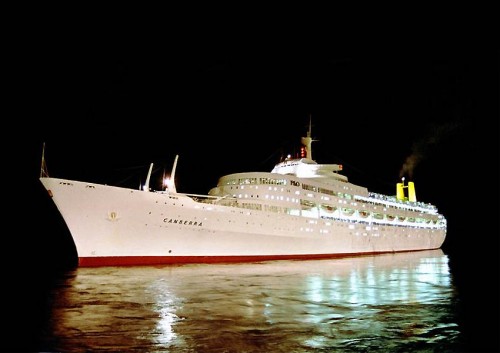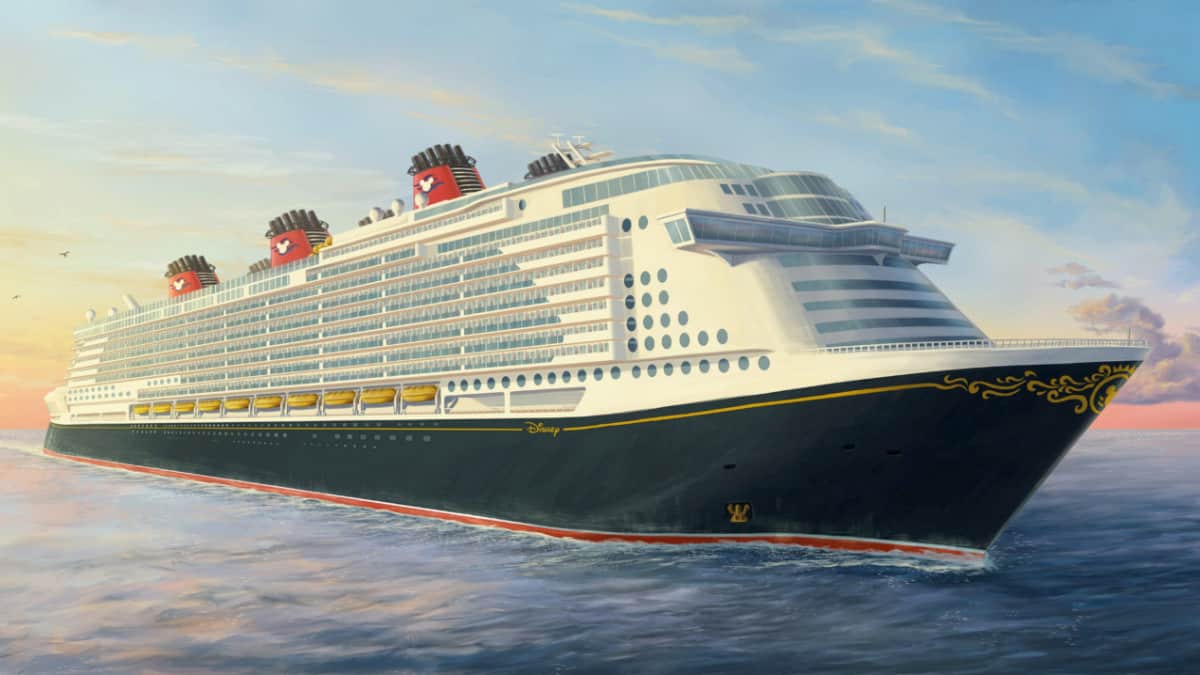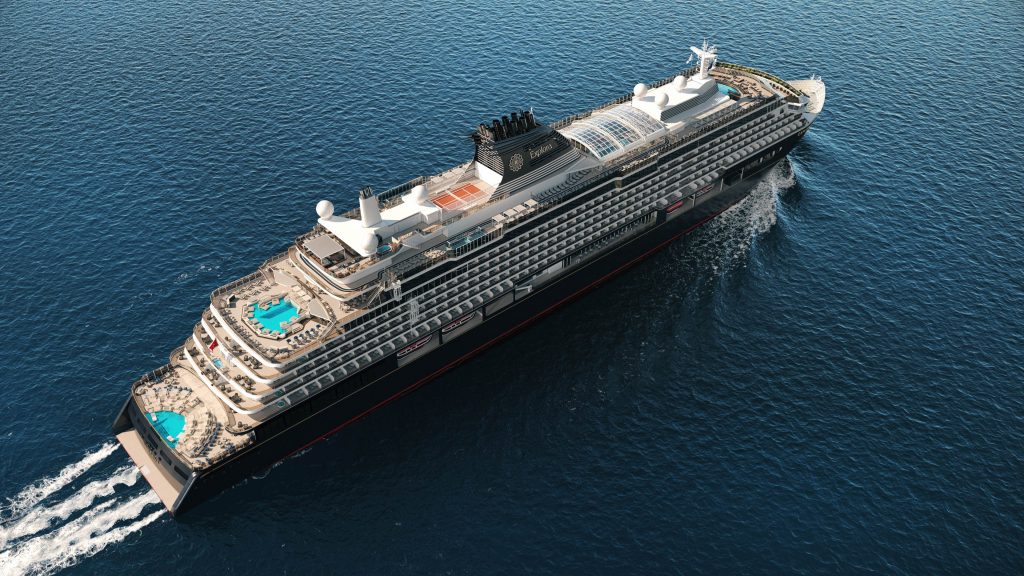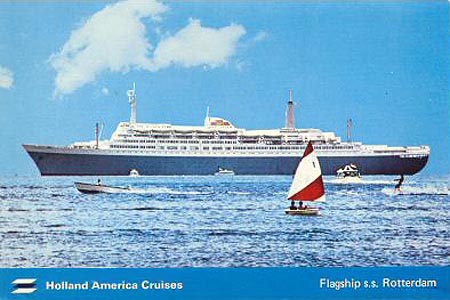In 1956, P & O ordered a new flagship from the Belfast based yard Harland & Wolff (famous for building the ill-fated liner Titanic among others). The ship was to be of 45.000 gross tons, a length of 814 ft and a beam of 103 ft. Both inside and out, she would be most modern. Her machinery was to be placed aft, her funnels also. She was to have twin funnels, placed side-by-side. A most uncommon design in these days, seen first in the Shaw Savill Liner Southern Cross (also built by Harland & Wolff by the way).
Canberra was to have two other special features: first, for her superstructure, about 1000 tonnes of welded aluminium was used, saving ca. 1500 tons deadweight, and making an extra 200 cabins possible. Second, her lifeboats were not placed on the boat deck, as was usual in these days, but would sit in recesses in the superstructure. For safety reasons (distance to be covered to the waterline is much less) this is common practice when building today’s mega cruise liners. Of course as a pleasant side-effect this would increase deck space significantly.

Her first keel plates were laid in September 1957, and half a year later, her name was announced: Canberra (apart from being the name of Australia’ s capital city, this is also an aboriginal word meaning ¨ meeting place by the water ¨). She was launched in March 1960, with more than 10.000 onlookers watching her slide into the Musgrave Channel. Trials started in April 1961. Because of the weight of her machinery being placed aft, her bulbous bow lifted almost clear of the water when sailing at full speed. This was rectified by filling her forward part with concrete as a counterweight.
Then, on June 2nd 1961, Canberra left Southampton for her maiden voyage, fully booked. All went well until a problem with one of the ship’s condensers caused a delay in Aden, where a complete power failure occurred. With no airconditioning, passengers were informed they could sleep on deck if they wanted. Canberra finally reached Australia, about a day and a half late, as underway the condenser-problem had reoccurred. She continued her maiden voyage calling at Auckland, Honolulu, Vancouver, San Francisco, Los Angeles before crossing the Pacific again. Via Wellington, Sydney, Colombo, Aden and Suez she returned to Southampton, having steamed 42,000 miles! When she arrived in Southampton in September 1961 her maiden voyage had been a great success, cutting the passage to Sydney by a week.
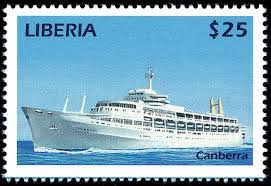
Next, Canberra made another three line voyages before starting out on her first cruise. On January 4th 1963, she was sailing east in the Mediterranean when a fire fed electrically by the generators was discovered in the engine room. Without power, and with her lower decks beginning to fill with smoke, her passengers were ordered to their muster stations. Luckily, the fire was under control within an hour. The next day, power was restored and she limped to Malta. Then, P&O managed to fly 1700 of her passengers to their destinations within a week. Canberra needed help from her most important competitor, the aircraft…………. Back at the yard, it took Harland & Wolff 4 months to get her back into service.

In 1965, three of Canberra‘s cruises were cancelled because of a strike of British seamen, which lasted for 45 days. They wanted an increase in pay and a shorter working week. Shipping companies refused this as the year before, seamen had received higher salaries already.
At the end of the sixties, more and more travellers were flying to Australia. On top of this, the Australian government restricted the number of immigrants. Canberra saw her passengers loads decline. To make matters worse, fuel costs were rising……
Then, P&O tried something new: they planned a series of cruises in American waters, some to the Caribbean. Unfortunately, bookings were so low, that after having made just two cruises, it was decided to take Canberra out of service. However, within weeks, she was cruising again, completing her planned cruises.
Canberra found herself in trouble when P&O decided that she wasn’t really suitable for cruising. She had lost half a million pounds in just over half a year. So P&O wanted to sell the ship, if necessary to the scrappers although she was just 12 years old. Indeed, her fuel hungry machinery and her draft were drawbacks.
Then, suddenly cruise bookings in general increased significantly, and Canberra was sent cruising again, taking over Orsova‘s 1974 programme. Back in England, she was turned into a one class cruise ship. Together with Arcadia and Oriana, Canberra sailed through the seventies. In 1980 she was given new propellers and combustion equipment, which together with a slightly reduced speed made her operate much more efficiently.
In April 1982 the British government assembled a fleet consisting of warships, fleet auxiliaries and STUFT’s, which means “ships taken up from trade”. They were needed to drive away an Argentine invasion force which had seized control of the Falkland Islands. Called back to Southampton, she was fitted with two helicopter decks and made ready to receive her new passengers: British soldiers. Canberra was transformed from a cruise ship to a warship in just 3 days!

She was back in her old role in September 1982, and continued sailing from Southampton or Sydney. Among her passengers were many repeaters, as the ship was known for her friendly atmosphere. In 1986, Canberra was sent to Lloyd Weft in Germany, where her cabins and public spaces were upgraded. During that same year, Oriana had been withdrawn from service after it had become clear that P&O would have to downgrade to becoming a single ship line and it was obvious that her fleetmate Canberra was the more structurally sound vessel of the two.
At the end of the eighties, she was beginning to show her age, developing (minor) mechanical troubles which became more serious as time went by. At the end of her career, technically she was not well. So, as could be expected, in 1991 P&O announced plans for a newbuilding to replace Canberra. The following year, this resulted in an order for a cruise ship of appr. 67.000 tons given to Meyer Werft in Germany.
Finally, on June 25th 1996, P&O announced that Canberra would be retired from service on September 30th 1997. She was to be replaced by Star Princess, which would be renamed Arcadia.
She would be withdrawn just before the introduction of new safety rules.
After she had been beached at the scrapyard in India, it took the scrappers over a year to dismantle her. This was much more than the three to four months they had expected. She was built so sturdily, that it is said that the scrappers lost money on her…

Series of postcards…..








